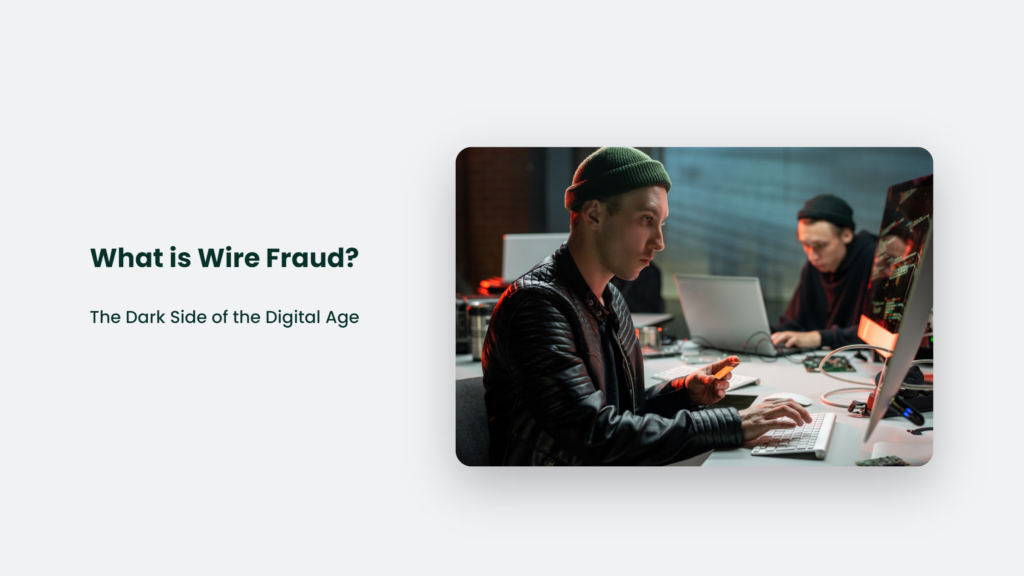Today’s fast-paced digital world is constantly bombarded with news about the latest scams and frauds. But have you ever stopped to think about what is wire fraud? Well, buckle up because we’re about to dive deep into the murky waters of this cybercrime.

What is Wire Fraud?
Wire fraud is a type of financial fraud that involves the use of electronic communications, such as email, phone calls, or social media, to deceive victims into transferring money or valuable assets to the fraudster. It’s like a modern-day version of the classic con artist but with a digital twist.
The Anatomy of Wire Fraud
Wire fraud is a complex and multifaceted crime that can take many forms. To better understand its anatomy, let’s explore some of the most common tactics and techniques used by these digital con artists:
- Phishing: As mentioned earlier, phishing involves sending emails or messages that appear to be from a legitimate source, such as a bank or a trusted company, to trick victims into revealing sensitive information, like usernames, passwords, or account numbers.
- Impersonation: In impersonation scams, fraudsters pretend to be someone the victim knows, like a friend, family member, or coworker, and ask for money or personal information.
- Business Email Compromise (BEC): BEC scams target businesses by hacking into their email systems and impersonating company executives or vendors to request fraudulent wire transfers.
- Non-delivery fraud: Wire fraud occurs when a scammer offers goods or services they never intend to deliver, often using fake websites or online marketplaces to lure victims.
- Extortion: In extortion scams, criminals use threats or intimidation to force victims into sending money or valuable assets.
- Personal data breach: This wire fraud involves stealing sensitive personal information, such as Social Security numbers or credit card details, and using it to commit identity theft or other fraudulent activities.
- Real estate wire fraud: Real estate transactions are particularly vulnerable to wire fraud, with criminals often impersonating title companies, real estate agents, or closing attorneys to trick buyers into sending funds to the wrong bank account.
- Government impersonation scams: In these scams, fraudsters pose as government officials, such as IRS representatives, and threaten victims with arrest or other consequences if they don’t send money.
It’s important to note that many of these tactics can be combined or used in conjunction with one another to create even more sophisticated and convincing scams. For example, a phishing email might be used to obtain a victim’s login credentials, which are then used to carry out a BEC scam.
As you can see, wire fraud is a diverse and ever-evolving crime that can take many forms.
By understanding these digital swindlers’ various tactics and techniques, you’ll be better equipped to recognize and avoid falling victim to their schemes. Stay vigilant, and remember that knowledge is power in the fight against wire fraud.
The Staggering Statistics: Wire Fraud’s Alarming Impact
Wire fraud is a growing problem that’s costing individuals and businesses billions of dollars each year. Here are some jaw-dropping statistics to put things into perspective with proper sources:
- In Hong Kong, personal data fraud, which is a type of wire fraud, has been on the rise, with criminals using stolen personal data to carry out fraudulent bank transactions and other illicit activities.
- Cyberthieves often steal personal information to drain bank accounts or make fraudulent online credit card purchases, using email, mobile phones, and social media as their primary tools.
- The FBI has identified phishing, non-delivery fraud, extortion, and personal data breach as the most widespread examples of wire fraud.
- According to the Federal Trade Commission’s data from 2022, reported consumer losses to fraud have been increasing, with scammers finding more success in their illicit activities.
- A recent case highlighted by Good Morning America showcased a sophisticated wire transfer fraud, emphasizing the need for increased awareness and vigilance among potential victims.
These statistics underscore the importance of staying informed and proactively protecting yourself and your assets from wire fraud. By understanding the scope and impact of this crime, we can better equip ourselves to recognize and avoid falling victim to these digital swindlers.
The Art of Wire Fraud Prevention: A Comprehensive Guide
Protecting yourself from wire fraud requires a combination of vigilance, education, and the right tools. Here’s an expanded list of tips and strategies to help you stay one step ahead of these digital con artists:
- Stay vigilant: Always look for red flags, such as unsolicited emails, requests for sensitive information, or urgent demands for money.
- Verify: If you receive a request for a wire transfer or personal information, take the time to verify the legitimacy of the request by contacting the person or company directly through a known, trusted method.
- Educate: Make sure you and your employees are aware of the risks of wire fraud and the best practices for prevention.
- Use two-factor authentication (2FA): One of the most effective ways to protect your accounts from unauthorized access is by enabling 2FA, which requires a second form of verification and your password.
- Keep your software up-to-date: Regularly update your operating system, browser, and security software to protect against known vulnerabilities and threats.
- Monitor your accounts: Regularly review your bank and credit card statements for suspicious or unauthorized transactions.
- Be cautious with public Wi-Fi: Avoid using public Wi-Fi networks for sensitive transactions, as they can be more vulnerable to hacking and eavesdropping.
- Secure your devices: Use strong, unique passwords for all your accounts and devices, and consider using a password manager to help you keep track of them.
- Beware of social engineering: Be cautious when sharing personal information on social media or other public platforms, as criminals can use this information to craft targeted scams.
- Report suspicious activity: If you suspect you’ve been a victim of wire fraud, report it to your local law enforcement agency, your bank, and the FBI’s Internet Crime Complaint Center (IC3).
By implementing these strategies and staying informed about the latest wire fraud tactics, you can significantly reduce your risk of falling victim to these digital scams.
Remember, knowledge is power, and staying one step ahead of the criminals is the best way to protect yourself and your assets.
Frequently Asked Questions:
Is wire fraud a federal crime?
Yes, wire fraud is a federal crime in the United States, punishable by up to 20 years in prison and hefty fines.
Can wire fraud be reversed?
In some cases, wire transfers can be reversed if the bank is notified quickly enough. However, once the funds have been transferred to the fraudster’s account, it can be challenging to recover the money.
How can I report wire fraud?
If you believe you’ve been a victim of wire fraud, you should report it to your local law enforcement agency, your bank, and the FBI’s Internet Crime Complaint Center (IC3).
The Bottom Line:
In conclusion, wire fraud is a sinister side effect of our increasingly connected world. But with vigilance, education, and a healthy dose of scepticism, we can all do our part to keep these digital con artists at bay.
So, the next time you receive an email or message that seems too good to be true, remember the wise words of Mark Twain: “A lie can get halfway around the world before the truth can even get its boots on.” Stay sharp, and don’t let wire fraud pull the wool over your eyes.




